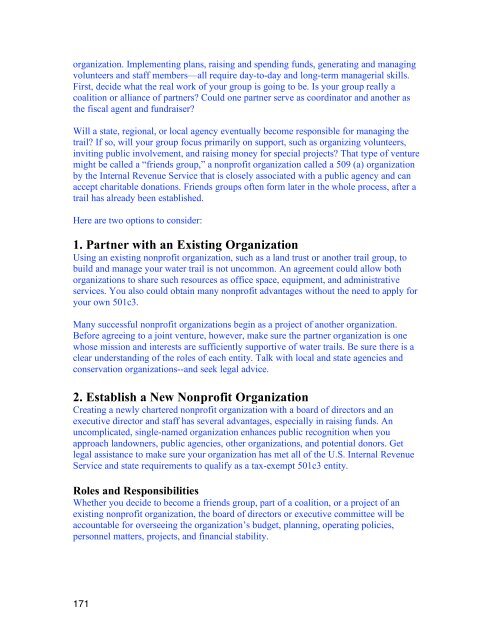Draft Interpretive Plan Join the adventure! - Captain John Smith ...
Draft Interpretive Plan Join the adventure! - Captain John Smith ...
Draft Interpretive Plan Join the adventure! - Captain John Smith ...
You also want an ePaper? Increase the reach of your titles
YUMPU automatically turns print PDFs into web optimized ePapers that Google loves.
organization. Implementing plans, raising and spending funds, generating and managing<br />
volunteers and staff members—all require day-to-day and long-term managerial skills.<br />
First, decide what <strong>the</strong> real work of your group is going to be. Is your group really a<br />
coalition or alliance of partners? Could one partner serve as coordinator and ano<strong>the</strong>r as<br />
<strong>the</strong> fiscal agent and fundraiser?<br />
Will a state, regional, or local agency eventually become responsible for managing <strong>the</strong><br />
trail? If so, will your group focus primarily on support, such as organizing volunteers,<br />
inviting public involvement, and raising money for special projects? That type of venture<br />
might be called a “friends group,” a nonprofit organization called a 509 (a) organization<br />
by <strong>the</strong> Internal Revenue Service that is closely associated with a public agency and can<br />
accept charitable donations. Friends groups often form later in <strong>the</strong> whole process, after a<br />
trail has already been established.<br />
Here are two options to consider:<br />
1. Partner with an Existing Organization<br />
Using an existing nonprofit organization, such as a land trust or ano<strong>the</strong>r trail group, to<br />
build and manage your water trail is not uncommon. An agreement could allow both<br />
organizations to share such resources as office space, equipment, and administrative<br />
services. You also could obtain many nonprofit advantages without <strong>the</strong> need to apply for<br />
your own 501c3.<br />
Many successful nonprofit organizations begin as a project of ano<strong>the</strong>r organization.<br />
Before agreeing to a joint venture, however, make sure <strong>the</strong> partner organization is one<br />
whose mission and interests are sufficiently supportive of water trails. Be sure <strong>the</strong>re is a<br />
clear understanding of <strong>the</strong> roles of each entity. Talk with local and state agencies and<br />
conservation organizations--and seek legal advice.<br />
2. Establish a New Nonprofit Organization<br />
Creating a newly chartered nonprofit organization with a board of directors and an<br />
executive director and staff has several advantages, especially in raising funds. An<br />
uncomplicated, single-named organization enhances public recognition when you<br />
approach landowners, public agencies, o<strong>the</strong>r organizations, and potential donors. Get<br />
legal assistance to make sure your organization has met all of <strong>the</strong> U.S. Internal Revenue<br />
Service and state requirements to qualify as a tax-exempt 501c3 entity.<br />
Roles and Responsibilities<br />
Whe<strong>the</strong>r you decide to become a friends group, part of a coalition, or a project of an<br />
existing nonprofit organization, <strong>the</strong> board of directors or executive committee will be<br />
accountable for overseeing <strong>the</strong> organization’s budget, planning, operating policies,<br />
personnel matters, projects, and financial stability.<br />
171








